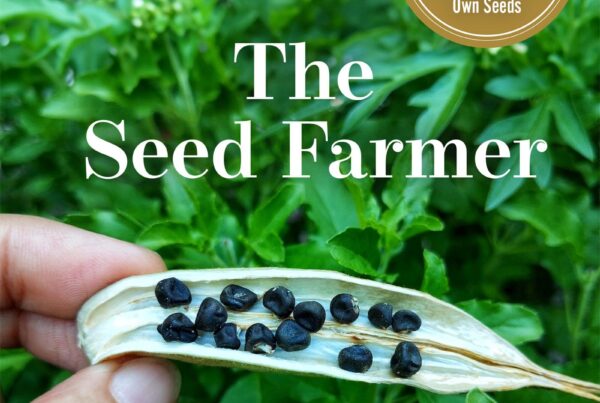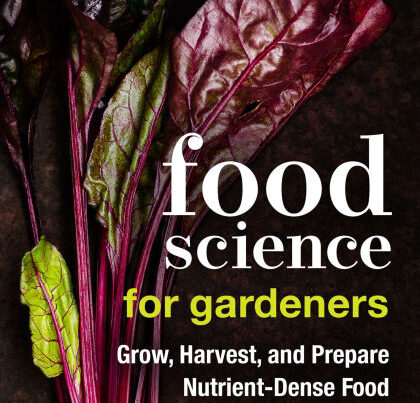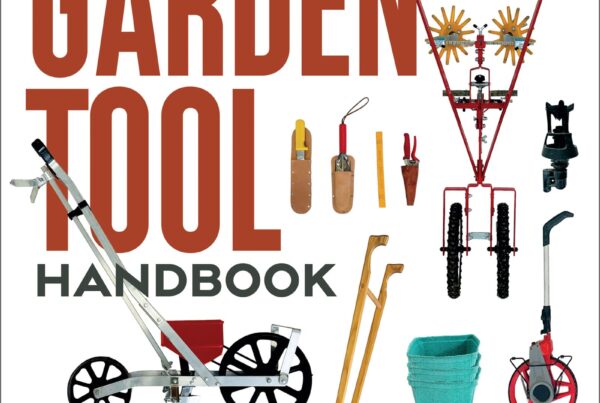Book Review: Will Bonsall’s Essential Guide to Radical, Self-Reliant Gardening
Innovative Techniques for Growing Vegetables, Grains, and Perennial Food Crops with Minimal Fossil Fuel and Animal Inputs. Chelsea Green, 2015
By Pam Dawling
In 1971, Will Bonsall went back to the land in Maine, with his wife, Molly Thorkildsen, and their two sons. They built the farm over the course of five years, “one foundation stone and one exquisitely harvested and finished piece of wood at a time. As neat and efficient as a ship’s cabin, Khadighar Farm rises up on a hillock in the midst of 85 acres.” (Press Herald 2014). Will Bonsall runs the Scatterseed Project, (as featured in the documentary “Seed: The Untold Story“), an organization for the collection, preservation and sharing of seeds. Jim Gerritson, in his endorsement says “The risk of describing [this book] as a gardening book is that the aspiring reader may miss the reality that it is really a book on life, centered as a good life should be, around a garden.”
Will Bonsall’s gardening (life) is focused on Veganism and Eco-efficiency, looking deeply into replenishing the soil by considering each organism’s intrinsic energy as a food in proportion to the food energy (or soil fertility) required to produce it. Only photosynthetic plants actually produce a net increase over the soil-derived nutrients they consume. All animals have a negative ratio. This is not to say all livestock are bad (or for that matter, that people are bad). Different animals vary in their Eco-efficiency and different terrains respond to different treatment. As the author says, you can pick and choose from the ideas presented, without needing to agree 100% with his ideology. And before anyone imagines that Will Bonsall advocates isolationist self-sufficiency, note that he points out that the most stable solutions for hard times involve cooperative, collective, community action.
The book starts with building soil fertility, moves on to growing and saving seeds and propagating plants, then discusses growing particular crops (vegetables, grains, pulses, oil seeds, and “permacrops”. Part 4 explains how these strategies are integrated to make best use of the land, and how to deal with pests and diseases. The book closes with some ideas for using and preserving the foods grown. As with all agriculture, there is not a linear progression of topics, but a network of ideas.
The bottom line on soil fertility is that how we balance the efficiencies of tilth-building imports will determine the long-term sustainability of our farm (and our planet). What are the true costs of bringing in soil-building materials? Here are good instructions on making compost, from the variable ingredients you are likely to have. Will uses 900 pounds (408.2 kg) per 180 ft2 (16.7m2). For some time I’ve been curious about how much compost other growers use. We use about 46 gals/100 ft2 in our hoophouse. Most other professional compost-using growers who I know of use 12-40 gals/100 ft2. How to compare weights with volumes? Perhaps 3.5 lbs/gal? At that density, Will’s rate is 143 gals/100 ft2. It does look very generous in the photo, but perhaps I have miscalculated. He does not report excess phosphorus in his soil, which is one of the main concerns about using lots of compost. Because he commends buckwheat as a cover crop for making soil phosphorus available to plants, I deduce he doesn’t have a surplus. Perhaps the relatively closed nutrient system on his farm reduces the potential problem. Perhaps it is the lack of animal manure.
Among other cover crops discussed here, sweet clover comes out well, for tolerating sodium, making deep roots, fixing nitrogen and bringing up more phosphorus. And growing so tall it can be mowed and the top growth taken for compost-making. Alfalfa has similar features, but is not so cold-hardy. (Khadighar Farm is in Maine.)
While Will’s farm is veganic agriculture, he is still a grass farmer. He uses wood ash and ramial wood-chips (chipped small branches and brush) to improve his grassland, reckoning this more sustainable than farming cattle.
Will describes chopping out circles of cover crop to transplant squash into, as a way of extending the valuable life of the cover crop until the last minute. I’d caution southern growers about trying that. When squash grow fast they can quickly run over cover crops and make life difficult. I tried winter squash with buckwheat once and the crew never quite forgave me, as we had to wade in and pull up the buckwheat to prevent seeding.
I was very interested to read that his squash plants, having grown surrounded by oats and peas (flattened and covered with tree leaves) never get troubled by striped cucumber beetles (one of our more pesky pests). Ramial wood chips are a great way to build soil, if spread on the surface rather than turned in. Fungi will break down the material overtime. The key is to get the woody material locally, to be eco-efficient. We ask our electric co-op to unload their line-clearance chips near the end of our driveway.
Because importing minerals and other soil builders over large distances is not sustainable, it is wise to conserve minerals and recycle those nutrients on your own land as long as possible. Humanure is worth considering, if you are not selling Organically-Certified produce to others, as long as you can be sure it doesn’t have medications or diseases in it, and you are quite choosy about which crops you apply it to.
Will says “boron is most vulnerable to erosion via the marketplace”, meaning selling produce can deplete your soils of some minerals.
Woodash is a valuable resource (although I reckon southern growers get less wood ash than northern growers).Wood ash can help reduce soil acidity, but probably don’t apply more than 10-15 lbs/1000ft2 (4.5-6.8 kg/92.9m2).
The second section of the book is about understanding annual, biennial and perennial plants and how to propagate them by farming seeds, and storing them well to keep them viable. He doesn’t just work with open-pollinated varieties. He points out that some hybrids don’t contain much genetic diversity, “a detail no one wants you to know”. Many hybrid tomatoes will grow surprisingly true to type, as the parent lines are not very divergent to begin with. He suggests Sungold tomato as one example.
Next he explains various ways to clone plants (replicate them asexually) via suckers, layering, cuttings, grafting. I just learned that blood, sweat and tears are bad for grafting, as the cambium cells will be ruined!
The third section of the book (150 pages) is about various crops. These are divided into vegetables, grains, pulses, oilseeds and permacrops. Will Bonsall is, after all, aiming to grow a complete vegan diet. In the vegetables chapter, Will focuses on areas where he has a unique approach, or at least one not widely known about.
There is a valuable tip about not planting peas too early. Plant a week later, when the soil is warmer, and your harvest will start a few days later (not a full week later) than it would have, and more importantly, the yield will be higher. Early lettuce or Egyptian onions make good space-sharing companions with fava beans. Rather than pine because they are too far north to grow lima beans, the family grows white-seeded runner beans (Phaseolus coccineus) to use as dry beans. I loved runner beans as a green bean in England and here I learn that many white runner beans have names with the word “Lima” in them. Confused? No wonder!
I might follow Will’s tip and grow only Early Jersey Wakefield, Danish Ballhead and a red storage cabbage. I’ve spent years seeking the perfect combination of cabbages for early eating, storage and sauerkraut. Perhaps this is it? I like the EJW well enough already, although I also like the hybrid Faroa. A trick Will has for getting best use of space is to plant the EJW at 18” (45 cm) spacing, with kohlrabi transplants in between. The kohlrabi are harvested first, leaving space for the cabbage to reach its (small) full size. Lettuce is another option.
It’s always gratifying to read another garden author advocating for something we do too (bare-root transplants). He has details for growing your own bulb onion sets from a mid-July sowing (in NY). The keys to success include sowing thickly in very rich soil, and finding the right variety, as well as the right date – early enough to grow a plant bigger than a wispy seedling, but late enough so they can’t move straight into making seed heads the next spring when replanted. The plants need to die back and harden off for storage. It takes skill!
I’m going to look out for Chinese broccoli (B. oleracea var. alboglabra), Bonnie Best and Siletz early determinate tomatoes, yellow-fleshed potatoes (especially Granola) and Baxter OP sweet corn.
I appreciated reading Will’s explanation of the causes of the Irish Potato Famine. Food justice is as important as good gardening skills. Let’s stop blaming Late Blight (Phytophthera infestans) and look instead at the English landowners shipping out wheat, barley and beef, reducing their peasant workers to a diet of potatoes and dairy products, which (although very unjust) was adequate as long as the supply of milk lasted and until the reliance on a single variety of potato (Lumpers) brought them to starvation and desperation.
I just learned that cucumbers are rich in soluble silica, important for healthy teeth. Will describes this silica-dissolving property as “eating rocks”!
It’s often said how it’s hard to judge the mood behind someone’s email – are they angry? Tired and grumpy? Making a joke? Sometimes I was left wondering at some passages in this book. He starts one story out by mentioning his “patronizing chuckle” at his wife Molly’s suggestion of mulching their grain plots, follows it up with telling how well it worked when he did try it and how he always mulches grains now. I have to give him the benefit of my doubt when he ends the paragraph with “Yep, I’m totally convinced that’s one of the best ideas I’ve ever had.” He’s sailing close to obnoxious realities that most women have had to endure.
I appreciated the section on the types of millet. I’ve often been confused about the different types and how best to use them as cover crops. Naturally, I need my “climate zone glasses” on – Virginia has different weather from New York, and what’s true there is not necessarily true here.
Japanese millet – not frost hardy, not suitable for human food (tight hulls)
Proso millet – not frost hardy, short, early maturing, not much biomass, loose-hulled. All are very attractive to birds once seeds form.
For those wanting to venture into small-scale grain-raising, this book has the basics for wheat, triticale, barley, oats, rye, millet, rice, field corn, buckwheat, amaranth and quinoa.
Pulses are dry peas, beans, lentils and other legumes. Not many books have the detailed information found here.
The oilseed chapter proposes the less usual idea of using the ground oily seeds in food, rather than extracting the oil from the seeds, adding it to cooking, and then dealing with a byproduct. I have not read much on this subject since I reviewed Cindy Conner’s book, Grow a Sustainable Diet. In this chapter, Will discusses sunflowers, pepitas, flax, poppies, hazelnuts and some experimental crops. In their climate, peanuts, olives, oil palm, safflower and sesame won’t mature. They don’t grow rape/canola as a seed crop because they value it more as an early greens crop. I was fairly horrified to read that they are trying chufa (tiger nuts) because we have serious weed problems with both yellow and purple nut sedge, also known as chufa. Will says that this food crop is not invasive, and will die with the frosts. I’m not going to try that in Virginia in case it hybridizes with the weed kinds – that would be too terrible!
The “permacrops” are tree nuts like chestnuts, hazels, acorns, pea-shrub and honeylocust, and tree fruits, cane fruits, blueberries, hardy kiwis, autumn olive (invasive in Virginia), dogwood cherry (cornelian cherry), rose-hips, ribes, apples, plums, pears, medlars, mulberries. Then there are the non-woody permacrops such as Jerusalem artichokes (terrasols) and apios. I’d never heard of those – they are groundnuts (but not peanuts), and they can get invasive. Various minor tuberous crops are discussed, such as cattails, Chinese yams, crosnes, daylilies and nanny-berries (wild viburnum).
The fourth section is “The Garden in Context” (Rocks, water, land; pests and diseases; and “smaller footprints” – ways of increasing yields from a given space). There are clear instructions on digging trenches to drain overly wet areas. I am still unclear though, on how big (deep, wide) drains need to be if you fill them with rocks. When I was doing calculations for our hoophouse, I concluded that the size of the drains if filled with rocks would have to be enormous, as most of the trench would be occupied by the rocks, leaving little room for the water. Obviously, the gradient of the ditch makes a difference too, as well as the quantity of water we’re talking about. Worth careful consideration before digging! I like Will’s drawing of a stone culvert in the bottom of the trench, to preserve some open space for the water to run in.
As for increasing yields from a given area, Will clarifies the differences between Old World agriculture (many crops, methods, tools, livestock shared across a large area) and New World agriculture (more isolated, fewer crops (mostly frost-tender annuals), cultivation mostly in the lowlands, no plows, no livestock, mostly slash and burn cultivation with long crop rotations). Old World crops lend themselves better to close planting, although the vining New World crops make better use of vertical space, and fit better with mulched no-till systems.
I appreciated Will’s take on companion planting – it’s not so much that different crops “like” each other, as that they have few quarrels. Peas grow up a trellis and spinach, chard, lettuce or carrots can occupy the rest of the bed without competing with the shallow-rooted peas. The carrots use all the nitrogen from the soil, while the peas are self-sufficient. Edamame can grow in the aisles between sweet corn rows – Will sows the edamame seeds in the same furrows as the corn seed. The corn yields normally, but the edamame yield is reduced by about 50% compared to growing it in separate rows. But the overall yield of corn-plus-edamame is greater for the space. Will has tried and true examples and pointers on factors to consider when designing your own combinations: timing, root depth, fertility requirements, access to light.
“There is something inherently unnatural in any kind of farming.” “Chaos, change and instability are more the norm; the best we can do is exploit them to our temporary advantage.” We must deal with pests! Will’s recommendation is to haul all vegetable crop residues to a hot compost pile, even if no disease is apparent. And to practice serious crop rotations. Animal pests are a problem in inverse proportion to their size: big deer can be excluded. Flea beetles are a bigger problem. Will recommends brewing toxic rhubarb leaves, being careful not to have them anywhere near human food in a way that could cause lethal mistakes. Apply as a fine mist.
The last section is on using the harvest, including milling, baking, sprouting, freezing, fermenting and drying. I didn’t take so many notes on this section, but for those wanting to mill wheat and corn, make buckwheat noodles and bake breads, the info is there. Also for sprouting, malting, freezing, fermenting and dehydrating. Also using oilmeals rather than pressing oil.
At the back of the book there are lists of recommended tools and resources and a few thoughts about energy use and alternative technology. This is an excellent book for those wanting to produce as much of their needs from the land as possible, and also for those who enjoy reading about quirky persevering hard-working folk who are doing just that, perhaps with an eye to inching in that direction themselves. Even relatively experienced growers will find something new in this collection of detailed information based on lived experience.







